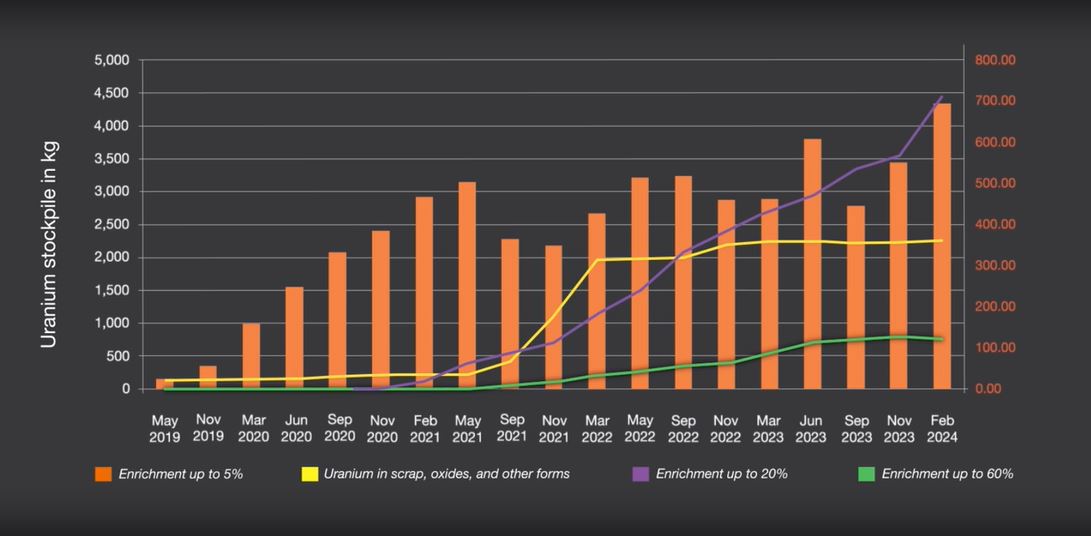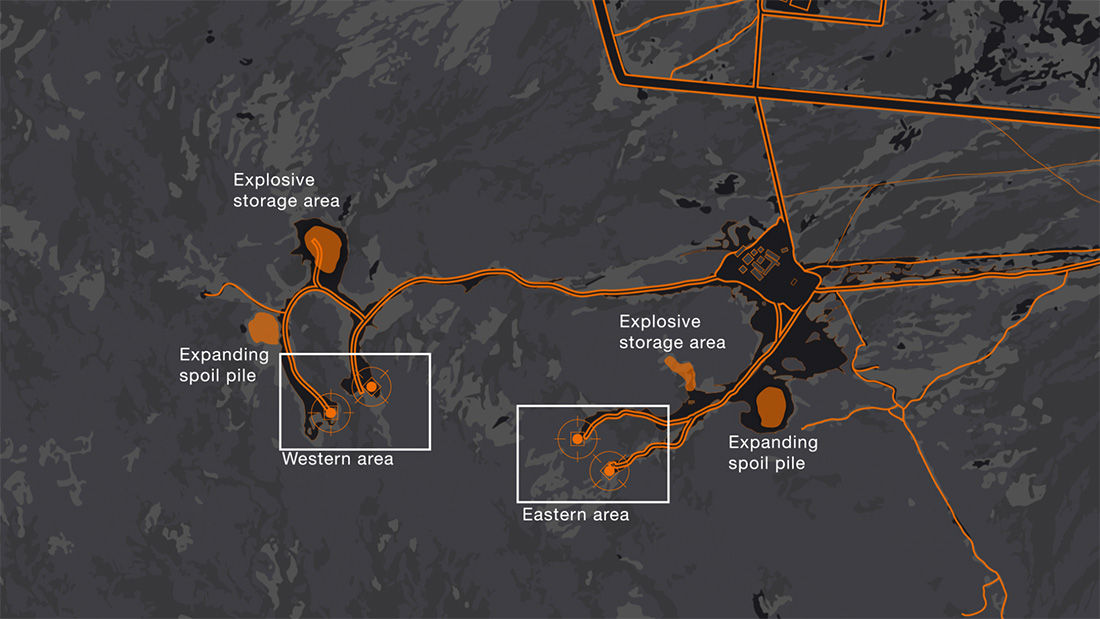Iran's nuclear programme
Using Janes assured foundational intelligence and interconnected data and analysis, which can be integrated into your own system, you can gain a situational awareness of Iran, its nuclear programme, as well as the country’s intent and progress in potentially achieving a viable nuclear weapons capability.
Iran has long been a country of interest given its location at the intersection between Central Asia, South Asia, and the Middle East, alongside its geopolitical and geoeconomic importance.

Iran's Joint Comprehensive Plan Of Action (JCPOA) violations
In recent years, Iran's nuclear programme has advanced at an alarming rate with limited transparency and has become a focus for tensions and concern among signatories to the Joint Comprehensive Plan of Action (JCPOA) and countries in the region.
In May 2018 the United States withdrew from the JCPOA and subsequently strengthened its sanctions on Iran. In 2019 former Iranian President Hassan Rouhani announced Iran’s partial withdrawal from the JCPOA and Tehran has since incrementally violated the JCPOA terms. This included the Iranian parliament passing a law directing the government to escalate its JCPOA violations by adopting reversible but significant violative measures.
Janes has been monitoring Iran’s enriched uranium stockpile since 2019. As of February 2024 Iran remains in significant violation of the JCPOA terms with enrichment levels reaching up to 60%.

Construction of a new underground facility
In September 2020 the Atomic Energy Organization of Iran announced that Iran would construct a new underground centrifuge assembly facility, located just south of the Natanz Uranium Enrichment Complex to secure the facility from potential airstrikes.
Janes Satellite Imagery Analysis first observed construction south of the Natanz Uranium Enrichment Complex around mid-2020. Construction and vehicle activity around this new site increased following an explosion on 2 July 2020 in which the Iran Centrifuge Assembly Center (ICAC), located overground at the Natanz site, was severely damaged. Janes continued to track activity at the site and verified a report from 22 May 2023 by the Associated Press, which estimated that each of the entrances had a width of 6 m and a height of 8 m. The scale of the work can be measured in large dirt mounds, two to the west, and one to the east. Based on the size of the spoil piles, seen in satellite imagery on 4 April 2023, Janes estimated that Iran is likely building a facility with a depth of 80–100 m.
Between January and April 2024, Janes observed satellite imagery which shows construction at the site is continuing, with a northern spoil pile at the western tunnel entrance increasing in size and the spoil pile at the eastern tunnel entrance also increasing.
The imagery also showed seven small structures being erected near the construction support area, and activity south of the new underground complex indicated that work on a perimeter wall was in progress.
Although Iran has officially indicated that the underground facility would be used to replace the ICAC facility, Janes assesses with moderate confidence that it is big enough to accommodate enrichment capabilities.
Iran's nuclear breakout time
Janes estimates that Iran’s breakout time – the time required to produce weapons-grade uranium enough for one nuclear weapon – is about six to seven days. This estimate is calculated based on the enrichment capacity of the centrifuges functioning at the Natanz complex using the existing stockpile of uranium enriched up to 60%. Janes also estimates that Iran can produce enough weapons-grade uranium for five to eight weapons in about one to two months.
However, Iran is not yet known to be capable of using weapons-grade uranium to make a nuclear weapon that can be mated with a delivery platform. The process of weaponisation is very likely to take a significantly longer period and the breakout estimate does not guarantee a nuclear weapon would be built, merely that enough weapons-grade uranium would be available.
Janes continues to monitor the developing nuclear situation in Iran. Using open sources, as of April 2024, there is no indication that Iran is pushing ahead with the weaponisation component of any process towards a nuclear weapons capability. However, Iran might covertly seek to do so. Other indicators to monitor are Iran’s
disposition towards continued International Atomic Energy Agency (IAEA)monitoring of its nuclear facilities and its approach to resolving outstanding issues with the IAEA on past undeclared nuclear activities within the country.
Transcript
Iran has long been a country of interest given its location at the intersection between Central Asia, South Asia, and the Middle East, alongside its geopolitical and geoeconomic importance.
In recent years, Iran’s nuclear programme has advanced at an alarming rate with limited transparency and has become a focus for tensions and concern among signatories to the Joint Comprehensive Plan of Action (JCPOA) and countries in the region.
In May 2018 the United States withdrew from the JCPOA and subsequently strengthened its sanctions on Iran. In 2019 former Iranian President Hassan Rouhani announced Iran’s partial withdrawal from the JCPOA and Tehran has since incrementally violated the JCPOA terms. This included the Iranian parliament passing a law directing the government to escalate its JCPOA violations by adopting reversible but significant violative measures.
Janes has been monitoring Iran’s enriched uranium stockpile since 2019. As of February 2024 Iran remains in significant violation of the JCPOA terms with enrichment levels reaching up to 60%. In September 2020 the Atomic Energy Organization of Iran announced that Iran would construct a new underground centrifuge assembly facility, located just south of the Natanz Uranium Enrichment Complex to secure the facility from potential airstrikes.
Janes Satellite Imagery Analysis first observed construction south of the Natanz Uranium Enrichment Complex around mid-2020. Construction and vehicle activity around this new site increased following an explosion on 2 July 2020 in which the Iran Centrifuge Assembly Center (ICAC), located overground at the Natanz site, was severely damaged. Janes continued to track activity at the site and verified a report from 22 May 2023 by the Associated Press, which estimated that each of the entrances had a width of 6 m and a height of 8 m. The scale of the work can be measured in large dirt mounds, two to the west, and one to the east. Based on the size of the spoil piles, seen in satellite imagery on 4 April 2023, Janes estimated that Iran is likely building a facility with a depth of 80–100 m.
Between January and April 2024, Janes observed satellite imagery which shows construction at the site is continuing, with a northern spoil pile at the western tunnel entrance increasing in size and the spoil pile at the eastern tunnel entrance also increasing.
The imagery also showed seven small structures being erected near the construction support area, and activity south of the new underground complex indicated that work on a perimeter wall was in progress.
Although Iran has officially indicated that the underground facility would be used to replace the ICAC facility, Janes assesses with moderate confidence that it is big enough to accommodate enrichment capabilities.
Janes estimates that Iran’s breakout time – the time required to produce weapons-grade uranium enough for one nuclear weapon – is about six to seven days. This estimate is calculated based on the enrichment capacity of the centrifuges functioning at the Natanz complex using the existing stockpile of uranium enriched up to 60%. Janes also estimates that Iran can produce enough weapons-grade uranium for five to eight weapons in about one to two months.
However, Iran is not yet known to be capable of using weapons-grade uranium to make a nuclear weapon that can be mated with a delivery platform. The process of weaponisation is very likely to take a significantly longer period and the breakout estimate does not guarantee a nuclear weapon would be built, merely that enough weapons-grade uranium would be available.
Janes continues to monitor the developing nuclear situation in Iran. Using open sources, as of April 2024, there is no indication that Iran is pushing ahead with the weaponisation component of any process towards a nuclear weapons capability. However, Iran might covertly seek to do so. Other indicators to monitor are Iran's disposition towards continued International Atomic Energy Agency (IAEA)monitoring of its nuclear facilities and its approach to resolving outstanding issues with the IAEA on past undeclared nuclear activities within the country.




